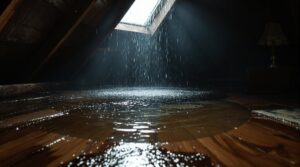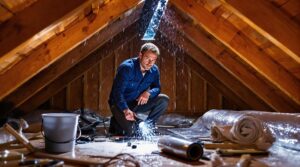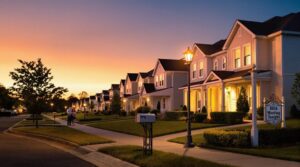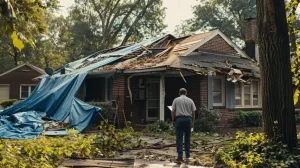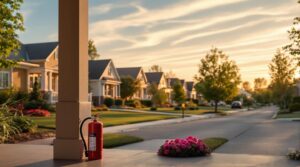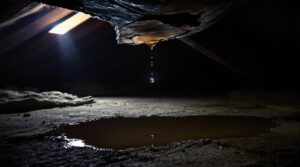Homeowners associations maintain specific obligations regarding roof leaks, with responsibilities outlined in governing documents like CC&Rs and bylaws. Coverage details vary by property type, with condominiums typically including roof maintenance under HOA master policies, while single-family homes often assign responsibility to individual owners. Insurance arrangements and maintenance obligations depend on the specific provisions in HOA documents. Legal remedies exist when associations fail to meet their obligations, with public adjusters offering expertise to maximize claim settlements.
Key Takeaways
- Review HOA governing documents (CC&Rs and bylaws) to determine specific responsibilities for roof maintenance and repair between HOA and homeowners.
- Condominium HOAs typically cover roof repairs as common elements, while single-family homes usually assign responsibility to individual owners.
- Document all roof leaks, maintenance requests, and HOA communications, including photos and repair records for potential claims or disputes.
- Check both HOA master insurance policy and individual homeowner’s policy to understand coverage overlap and gaps for roof-related damages.
- Consider hiring a public adjuster for complex claims, as they can increase settlement amounts by 20-50% through professional documentation.
Understanding HOA Structure and Governing Documents
When addressing roof leaks in homeowner association communities, a thorough understanding of the HOA’s governing documents is essential for determining maintenance responsibilities and resolving potential disputes.
HOAs operate under a structured framework of governing documents, primarily consisting of CC&Rs, bylaws, and community rules. These documents establish the specific obligations of both the association and individual homeowners regarding property maintenance and repairs.
Each HOA maintains unique provisions detailing the scope of coverage for roof leaks and related structural issues. The governing documents explicitly define which party bears responsibility for different maintenance scenarios, including roof repairs. Homeowners should familiarize themselves with their association’s specific policies to ensure they understand their obligations and rights. This is particularly important when it comes to HOA coverage for roof repairs, as misunderstandings can lead to unexpected out-of-pocket expenses. Additionally, regular communication with the HOA can provide clarity on whether certain repairs fall under the association’s responsibilities or the individual homeowner’s duties.
Homeowners must carefully review these documents to understand their rights and the extent of HOA obligations. Clear delineation of responsibilities within the CC&Rs helps prevent confusion and facilitates efficient resolution of maintenance issues.
This documentation serves as the primary reference point for addressing disputes between homeowners and the HOA regarding roof leak responsibilities.
Types of Properties and Their Impact on Roof Coverage
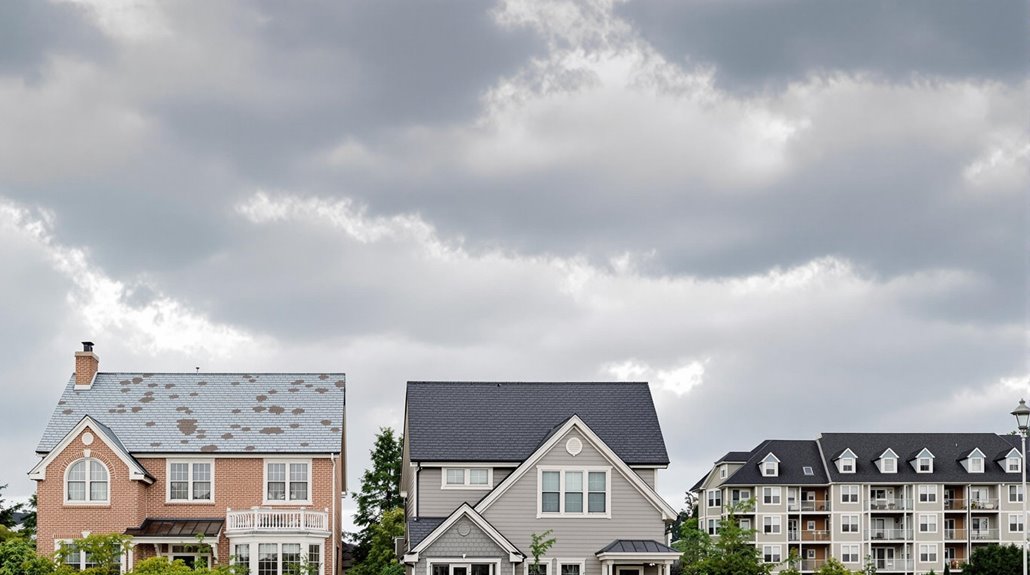
Different property types greatly influence HOA roof coverage responsibilities. Condominiums typically include roof maintenance as part of common elements, while single-family homes generally assign this responsibility to individual owners.
Townhouse communities present varying arrangements, as specified within their respective CC&Rs. Some HOAs assume full roof maintenance duties, while others limit their involvement.
Property owners must examine their specific HOA governing documents to determine the exact scope of roof coverage, as these agreements can contain unique provisions that deviate from standard practices.
Condo Vs Townhouse Coverage
Understanding the distinction between condominium and townhouse roof coverage remains essential for property owners subject to HOA governance. In condominiums, HOAs typically assume responsibility for roof maintenance as part of common element coverage, while townhouse arrangements vary based on specific CC&Rs. This fundamental difference affects both maintenance obligations and homeowners insurance policy requirements.
| Property Type | Typical Coverage | Maintenance Responsibility |
|---|---|---|
| Condominium | HOA Master Policy | HOA Managed |
| Townhouse | Varies by CC&Rs | May Be Owner or HOA |
| Mixed Use | Split Coverage | Defined in Documents |
Homeowners must carefully review their community’s governing documents to determine exact responsibilities, as coverage patterns can differ greatly between properties. Failure to maintain roofs according to established guidelines may result in denied claims, regardless of the responsible party.
Single-Family Home Obligations
Single-family homeowners within HOA communities bear primary responsibility for their roof maintenance and repairs, marking a distinct departure from condominium arrangements.
While HOAs maintain authority to establish guidelines regarding roof aesthetics and materials, the financial burden of maintenance and roof replacements falls squarely on individual homeowners.
The distinction between single-family homes and other property types is clearly defined in HOA governing documents.
Unlike shared structures where the HOA is responsible for common elements, single-family home roof coverage by HOAs is exceptionally rare.
Homeowners must carefully review their association’s documentation to understand their specific obligations.
While some HOAs may offer limited roof maintenance provisions, these arrangements represent uncommon exceptions rather than standard practice, and the primary responsibility typically remains with the property owner.
Property-Specific HOA Agreements
Property type considerably determines roof coverage obligations within HOA communities, with distinct arrangements applying to condominiums, townhomes, and single-family residences.
In multi-unit developments, HOAs typically assume responsibility for roof maintenance as these structures constitute common elements of the property.
Single-family homes generally operate under different parameters, with homeowners bearing direct responsibility for roof maintenance and repairs.
However, the homeowners association may still enforce specific guidelines regarding roof appearance and upkeep standards.
While rare, some HOA governing documents may establish unique provisions for limited roof coverage in single-family homes.
To determine exact responsibilities, property owners must carefully review their CC&Rs, as these documents explicitly outline the scope of HOA coverage and maintenance obligations specific to their property type.
Common Areas Vs Individual Unit Responsibilities
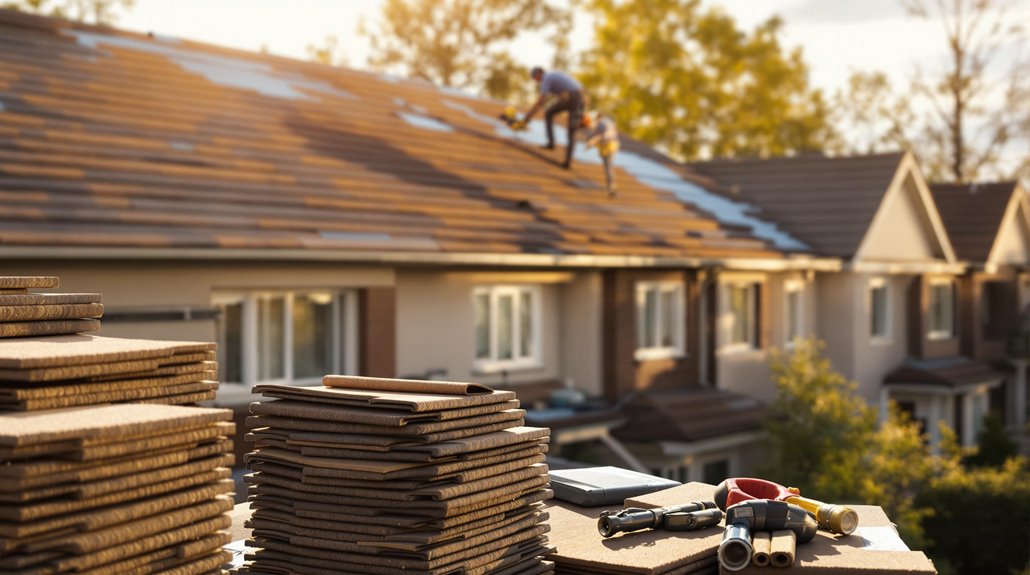
While determining responsibility for roof maintenance and repairs can be complex in homeowners associations, the distinction typically hinges on whether the property is a condominium, townhome, or single-family residence.
In condominium and townhome communities, roofs generally fall under common areas maintained by the HOA, with repairs covered by the master insurance policy. Individual units, however, remain the homeowner’s responsibility, including interior damage from roof leaks unless HOA negligence is proven.
The governing documents, specifically the CC&Rs, establish clear boundaries between HOA responsibilities and homeowner obligations.
Single-family homeowners typically bear full responsibility for their roofs unless explicitly stated otherwise in the association’s documents.
This differentiation between common areas and individual units often creates potential conflicts, making it essential for homeowners to carefully review their association’s governing documents to understand their maintenance and repair obligations fully.
Insurance Policies and Coverage Details
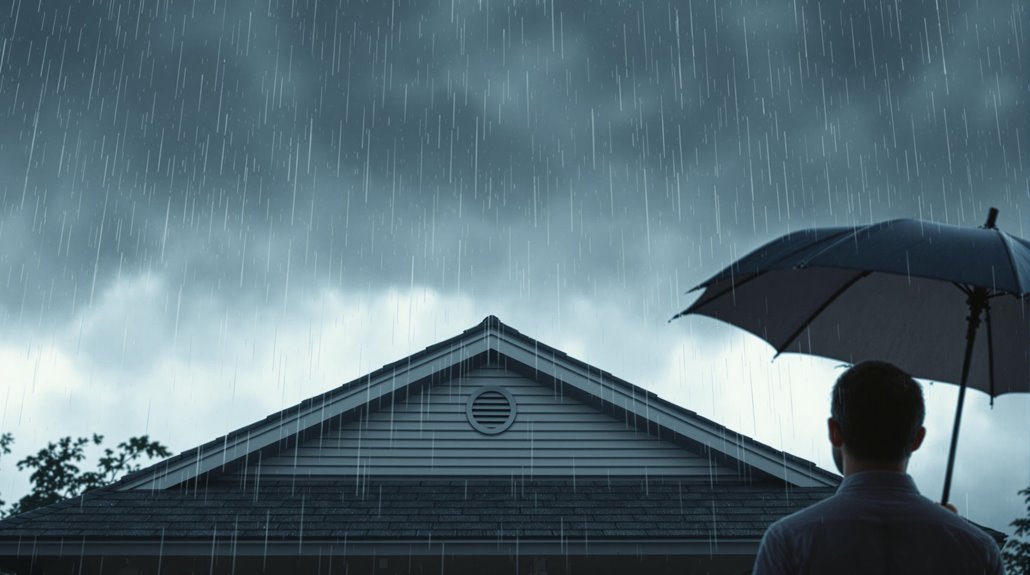
Understanding how insurance policies intersect with roof maintenance requires careful examination of both HOA master policies and individual homeowner coverage. The delineation between responsibilities becomes particularly essential when addressing roof leaks and subsequent water damage.
| Coverage Type | Typically Covers | Responsibility |
|---|---|---|
| HOA Master Policy | Common areas, structural elements | Association |
| Individual HO-6 | Unit interiors, personal property | Homeowner |
| Bare Walls Policy | External structures only | Mixed |
Insurance coverage details are explicitly outlined in the HOA’s governing documents, determining whether the association’s master policy extends to roof maintenance and repair. Individual homeowners must maintain separate coverage for their unit’s interior contents and improvements. When water damage occurs, the source of the roof leak becomes the determining factor in establishing whether the HOA master policy or the individual’s insurance assumes responsibility for repairs and restoration costs.
Steps to Take When Dealing With a Leaking Roof
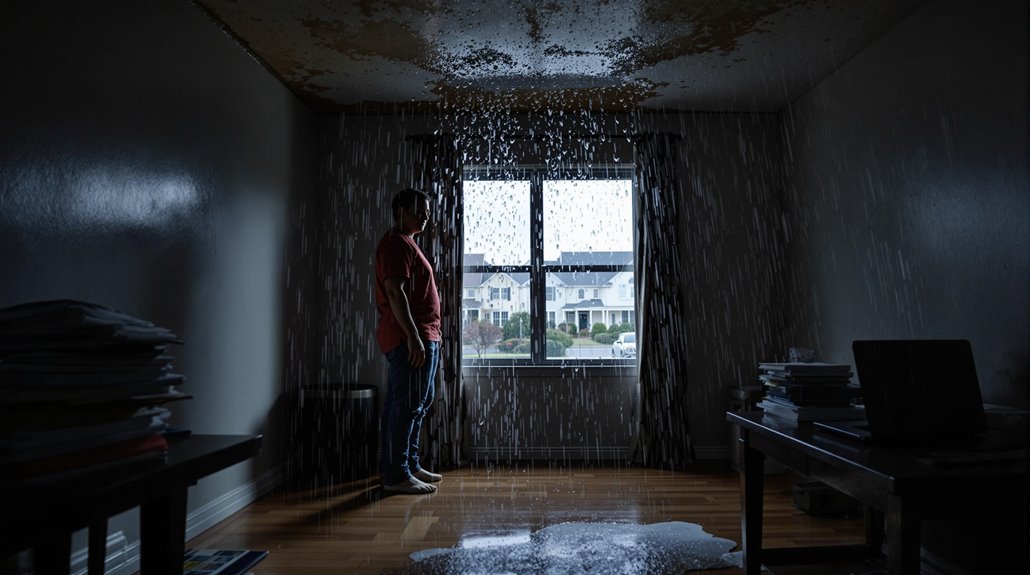
When homeowners encounter a leaking roof in an HOA community, following a systematic protocol can help resolve the issue efficiently and protect their interests.
The first vital step is reviewing the HOA’s governing documents to determine maintenance responsibilities and establish whether the HOA is responsible for roof repairs. Homeowners must notify the HOA in writing immediately upon discovering a leak, providing detailed information about damage to your unit and the duration of the problem.
Obtaining an independent assessment from a qualified roofing contractor and securing multiple repair estimates can strengthen the case for necessary repairs. Throughout the process, homeowners should document all communications with the HOA, including dates, times, and content of conversations or correspondence.
While administrative delays may occur due to volunteer board management, persistent follow-up is essential to guarantee the issue receives proper attention. This documentation becomes particularly valuable if disputes arise regarding repair responsibilities or the scope of necessary work.
Legal Rights and Dispute Resolution Options
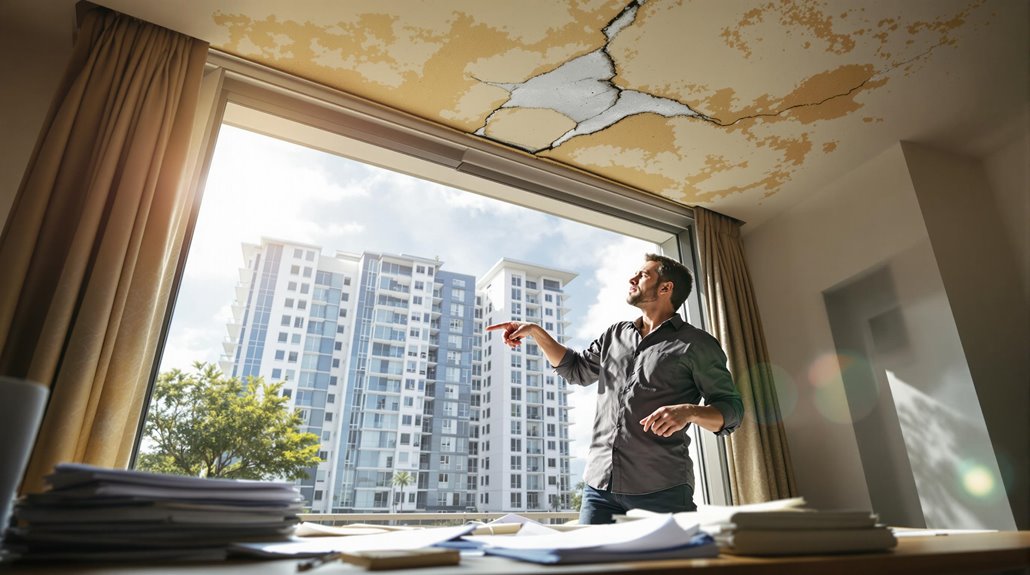
Should negotiations with the HOA prove unsuccessful, homeowners possess several legal avenues to address roof leak disputes. State laws governing HOAs typically establish clear guidelines regarding maintenance responsibilities and timeframes for repairs.
To protect their interests, homeowners must document all communications with their association, including repair requests, responses, and any evidence of damages.
When the HOA is responsible for repairs but fails to act, homeowners can pursue dispute resolution through mediation or arbitration. These alternatives often prove more cost-effective and expedient than traditional litigation.
If these methods prove insufficient, consulting a legal professional may become necessary to explore options for enforcing compliance or seeking compensation. The association may face liability for associated damages if their negligence in addressing roof leaks results in property damage or other losses.
Understanding these rights and remedies enables homeowners to effectively advocate for proper maintenance and repairs when dealing with unresponsive associations.
Financial Implications of Roof Repairs and Replacements
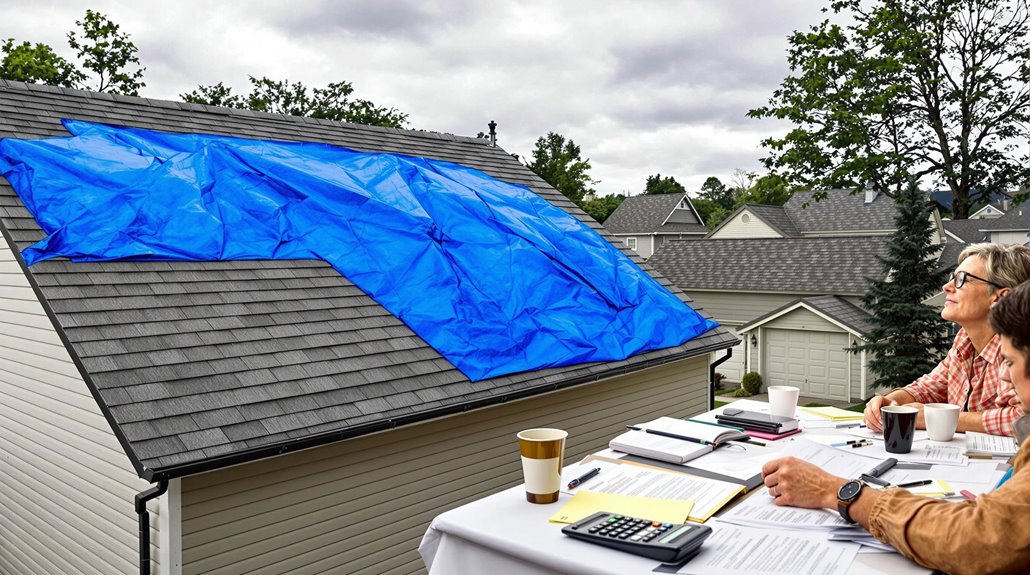
The financial burden of roof repairs in HOA communities often involves complex cost-sharing arrangements between the association and individual homeowners, requiring careful review of governing documents to determine specific obligations.
HOA reserve fund management plays a critical role, as insufficient reserves can lead to unexpected special assessments when major roof repairs become necessary.
Homeowners must understand their potential financial exposure, including responsibility for interior damage and repairs not covered by HOA policies, while considering financing options for their share of maintenance costs.
Cost Sharing Between Parties
Financial responsibility for roof repairs and replacements often creates complex cost-sharing scenarios between HOAs and individual homeowners, with nearly 70% of associations reporting insufficient reserves for major repairs.
When damage occurs, the HOA covers specific repairs based on governing documents, while homeowners may face additional expenses through special assessments or direct costs.
The distribution of financial responsibility frequently depends on maintenance history and the roof’s age. Even when the homeowners association assumes primary responsibility, inadequate reserves may necessitate cost-sharing arrangements.
These situations require careful negotiation and documentation to establish fair allocation of expenses. Disputes can arise when maintenance records are unclear or when the HOA denies coverage based on homeowner negligence, making it essential to maintain detailed records of all roof-related maintenance and repairs.
Reserve Fund Management
Maintaining adequate reserve funds stands as a critical responsibility for homeowners associations, yet nearly 70% lack sufficient reserves to address major roofing expenses without imposing special assessments. Proper reserve fund management requires regular studies and strategic planning to guarantee financial stability for future roof repairs and replacements.
- HOAs must conduct periodic reserve studies to assess funding requirements and establish appropriate contribution levels.
- Homeowners should review financial statements to verify adequate allocation for roof maintenance.
- Transparency in reserve fund management helps prevent disputes and guarantees accountability.
Without sufficient reserves, HOAs risk financial strain when urgent roof repairs arise, potentially leading to contentious special assessments.
Regular monitoring and adjustment of reserve funds protect both the association and homeowners from unexpected financial burdens while maintaining property values.
Best Practices for Roof Maintenance and Prevention
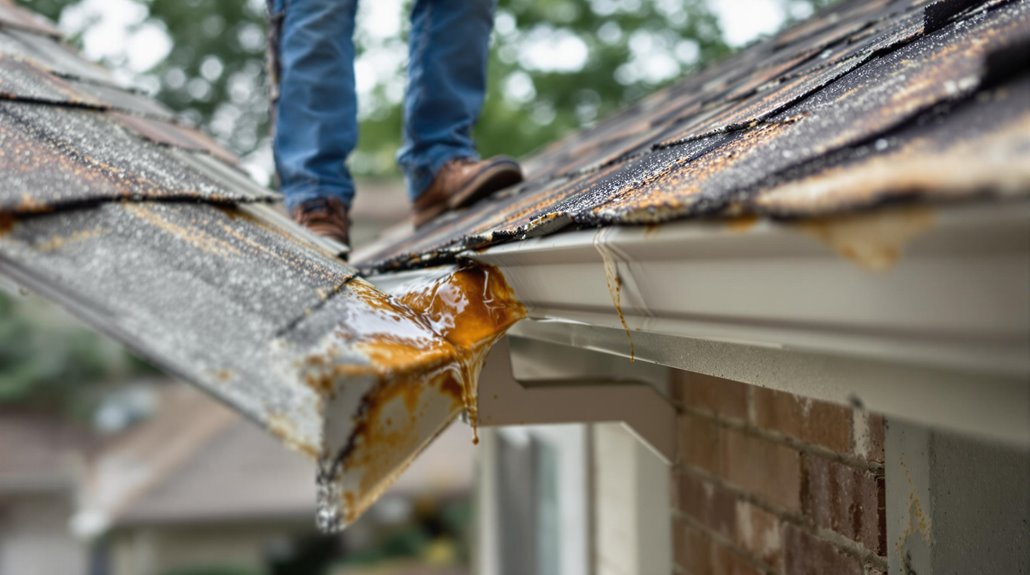
Proactive roof maintenance practices serve as a cornerstone of effective HOA property management and risk mitigation. Through the establishment of thorough maintenance guidelines within CC&Rs, HOAs can guarantee systematic adherence to essential maintenance protocols while clearly delineating homeowner responsibilities.
Regular inspections, conducted biannually at minimum, enable early detection of potential issues before they develop into considerable structural problems. Implementation of preventative measures, particularly focusing on gutter and downspout maintenance, greatly reduces the risk of water damage and extends roof longevity.
The selection of high-quality roofing materials, coupled with professional installation by qualified contractors, provides a foundation for sustained structural integrity.
Maintaining detailed repair records and documentation of maintenance activities serves dual purposes: facilitating informed decision-making for future maintenance needs and providing vital evidence during potential disputes regarding HOA responsibilities.
This systematic approach to roof maintenance ultimately protects property values while minimizing the association’s exposure to liability.
The Benefits Of Consulting A Public Adjuster
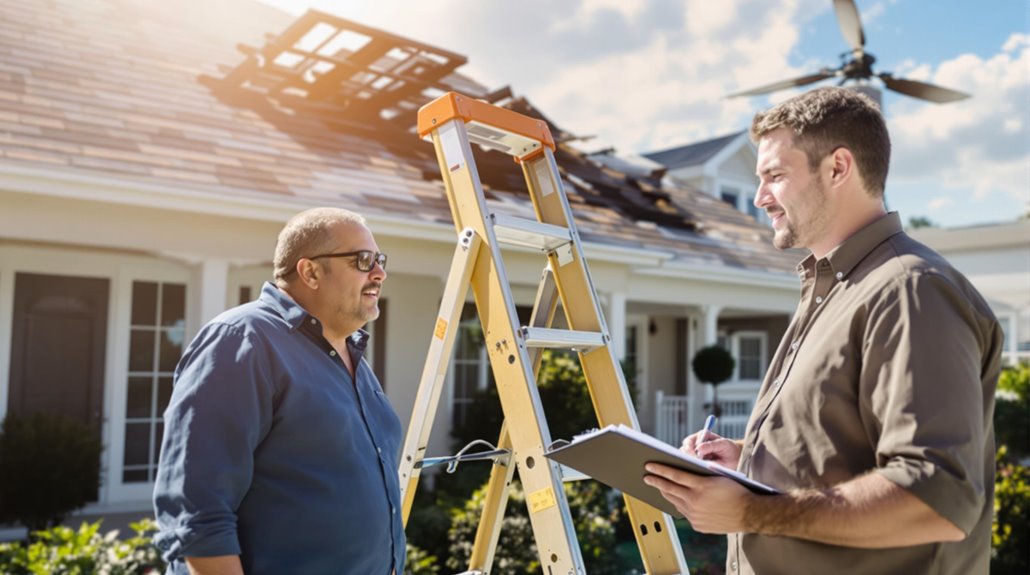
Public adjusters bring specialized insurance expertise that enables thorough and objective damage assessments for HOA roof claims.
Their involvement streamlines the claims process through professional documentation, policy interpretation, and strategic negotiations with insurance carriers.
Studies demonstrate that engaging a public adjuster typically results in considerably higher claim settlements, with payouts potentially reaching up to 800% more than claims handled without professional representation.
Expertise In Insurance Claims
When facing complex insurance claims for roof leaks and water damage, consulting a public adjuster can substantially improve a homeowner’s position in the claims process.
These licensed professionals possess extensive expertise in insurance claims and understand the intricacies of coverage opportunities that homeowners might overlook. Their thorough approach to damage assessment guarantees meticulous documentation and substantiation of claims with insurance companies.
- Public adjusters typically charge 5-15% of the claim amount, representing a strategic investment in maximizing settlement outcomes.
- Professional negotiation skills and knowledge of local regulations enhance the probability of favorable claim resolutions.
- Licensed adjusters manage all communications with insurance companies, allowing homeowners to focus on property restoration.
Their specialized knowledge and experience in handling complex claims make public adjusters valuable advocates during insurance negotiations, particularly in cases involving extensive water damage and structural issues.
Objective Damage Assessment
Obtaining an objective damage assessment through a licensed public adjuster constitutes a critical step in maximizing insurance claim outcomes for roof leaks and water damage. Public adjusters provide professional expertise in documenting and valuing damages, ensuring HOA responsibilities and homeowners’ rights are protected throughout the claims process.
| Assessment Benefits | Impact on Claims |
|---|---|
| Professional Documentation | 20-50% Higher Settlements |
| Hidden Damage Detection | Extensive Coverage |
| Policy Interpretation | Maximum Value Recovery |
| Negotiation Support | Reduced Stress Levels |
| Expert Representation | Protected Rights |
These licensed professionals identify concealed issues such as mold growth and structural damage that might otherwise go unnoticed. Their thorough understanding of insurance policies enables effective negotiation with carriers, resulting in markedly higher claim settlements compared to self-managed claims, while alleviating the burden of complex documentation requirements.
Streamlined Claim Process
To maximize efficiency and guarantee ideal claim outcomes, enlisting a public adjuster’s services streamlines the often complex insurance claims process for roof leak damages. These licensed professionals possess extensive knowledge of insurance policies and expertly navigate settlement negotiations, typically securing 20-30% higher compensation for homeowners compared to self-managed claims.
- Public adjusters conduct thorough evaluations of roof damage, ensuring detailed documentation that strengthens the claim’s validity.
- They identify and leverage all applicable coverage options within the policy, preventing potential oversights that could reduce settlement amounts.
- By managing all communications and paperwork with insurance providers, public adjusters alleviate the administrative burden while advocating for the homeowner’s interests.
This professional representation expedites claim resolution while maximizing the probability of obtaining fair compensation for roof-related damages.
Higher Claim Payouts & Settlements
Public adjusters consistently demonstrate their value by securing substantially higher claim payouts for homeowners with roof damage. Studies indicate that settlements achieved through public adjusters typically range from 20% to 50% higher than those handled independently.
Their expertise in understanding both HOA master policies and homeowners insurance enables them to maximize claim values effectively.
These professionals excel at steering the claims process by meticulously documenting evidence of damage and leveraging their knowledge during negotiations with insurance companies.
Working on a contingency fee basis, public adjusters are inherently motivated to secure the highest possible fair settlement.
Their thorough understanding of policy coverage, combined with their ability to properly assess and document property damage, proves instrumental in achieving ideal financial outcomes for homeowners facing roof-related claims.
About The Public Claims Adjusters Network (PCAN)
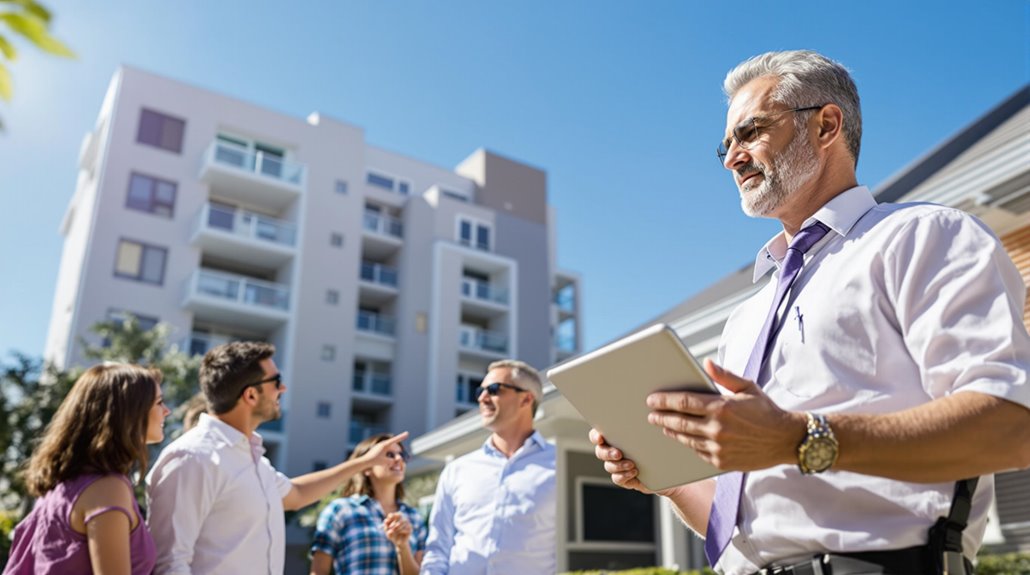
The Public Claims Adjusters Network stands as a nationwide organization comprising state-licensed public adjusters who have undergone rigorous vetting and verification processes.
PCAN serves as a critical resource for policyholders facing property damage insurance claims, including complex HOA roof repairs and master insurance policy matters.
Operating across 40+ states, PCAN member adjusters demonstrate expertise in over 30 different claim types, maintaining strict ethical and professional standards through mandatory annual audits.
Their specialized knowledge extends to various aspects of insurance claims, including:
- Assessment and documentation of property damage for HOA responsibilities
- Navigation of complex master insurance policy provisions
- Expert negotiation with insurance carriers for maximum claim settlements
PCAN’s intensive application and interview process guarantees only the most qualified public adjusters join their network, providing policyholders access to vetted professionals who can effectively manage their property damage claims while maintaining the highest standards of professional conduct.
Frequently Asked Questions
Does HOA Insurance Cover Roof Leaks?
In Skyview Condos, HOA insurance covered shared roof leaks affecting multiple units. Generally, HOA policies cover roof leaks in common areas, while individual homeowners are responsible for leaks confined to their units.
Who Is Responsible for a Roof Leak?
Responsibility for roof leaks depends on property assessments and community rules. In condominiums, HOAs manage roof maintenance, while single-family homeowners bear repair responsibilities unless governing documents specify otherwise. Legal obligations require prompt leak detection. Homeowners are encouraged to maintain regular inspections to prevent water damage and ensure structural integrity. A common concern among residents is understanding why roofs leak after repairs, as they may encounter recurring issues despite seemingly thorough work. Proper communication with roofing professionals and adherence to community guidelines can help clarify responsibilities and prevent future leaks.
Is HOA Responsible for Water Leaks?
When push comes to shove, HOA rules dictate water damage responsibility based on leak detection and property assessments. HOA covers common area leaks, while homeowners handle unit-specific maintenance responsibilities and insurance claims.
Who Is Typically Required to Warranty the Roof Against Leaks?
In condominium associations, HOAs typically maintain roof warranty obligations, while single-family homeowners bear responsibility for their own roofs, subject to governing documents and specific insurance policy details.
